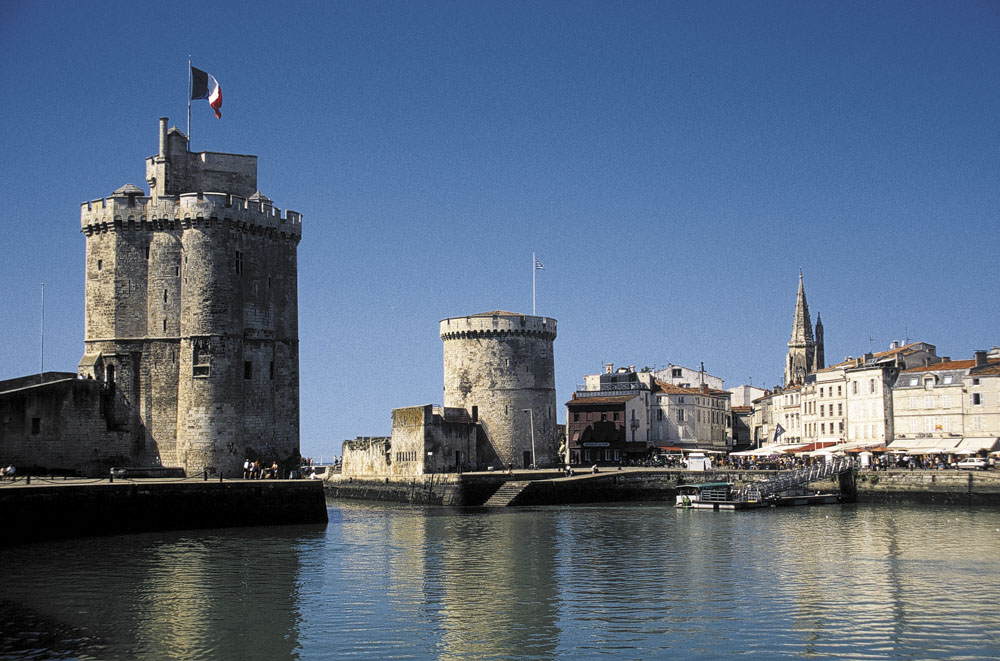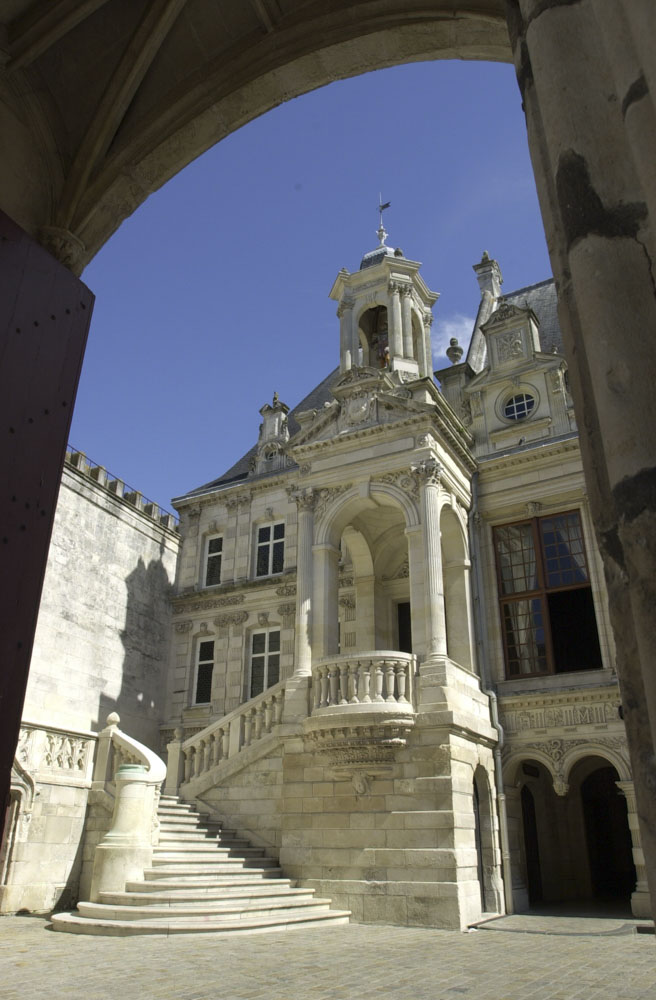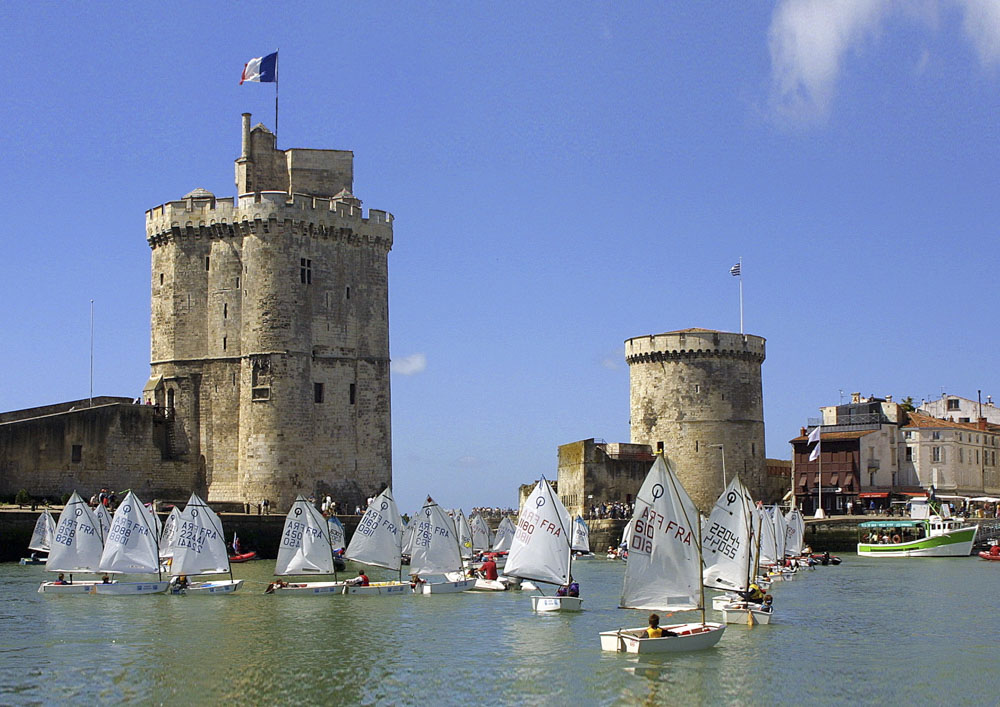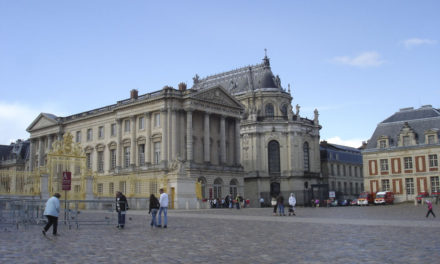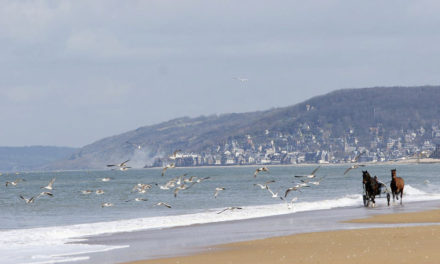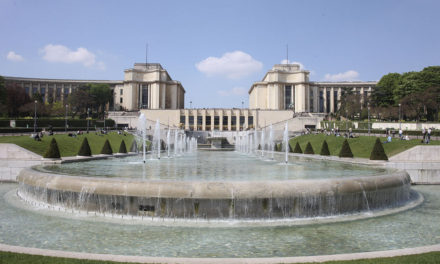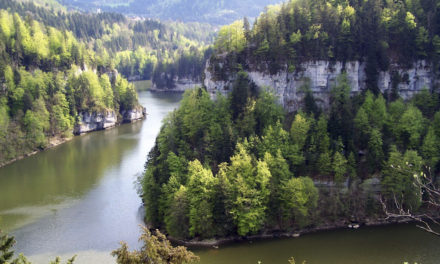The beautiful port of La Rochelle is situated on the Atlantic coast on the Bay of Biscay. It is the capital of the Charente-Maritime department in the region of Poitou-Charentes, western France which includes the idyllic islands of Ré, Oléron, Aix and Madame. La Rochelle has kept strong links with its maritime history possessing a deep water harbour named La Pallice which has seen the growth of commercial activity as well as the development of the largest marina for pleasure boats in Europe called Les Minimes which has moorings for 3,500 yachts. Known as La Ville Blanche (the White City) because of its brilliant white limestone cliffs, it is perhaps one of the most attractive, unspoilt seaside resorts in France. Limestone is traditionally used as the main building material throughout the region giving a much admired luminescence to the local architecture. With four ports and beaches, La Rochelle is the archetypal town of the Atlantic coast with a mild climate throughout the year (2,400 hours of sunshine), it is a popular choice for family holidays. Approximately 77,000 residents live in this dynamic city.
Book a Hotel in La Rochelle
History
Following occupation by the Romans, La Rochelle was originally founded during the 10th century as a fishing village. It became an important harbour in the 12th century and with a developing wine industry and salt production, goods were exported through the port trading throughout the Empire. In 1137, Guillaume X, Duke of Aquitaine, made La Rochelle a free port and gave it the right to establish itself as a commune. Under the communal charter, the city was authorised to mint its own coins and to operate some businesses free of royal taxes which helped the development of the entrepreneurs of the time.
The city eventually lost its trade and prominence during the decades spanning the Seven Years’ War, the French Revolution and the Napoleonic Wars. During this time France lost many of its territorial possessions and also saw a strong decrease in its sea power in the continuing conflicts with Britain. In 1628 Louis XIII and Richelieu laid siege to the city and the citizens faced famine and misery with hostilities between catholics and protestants wreaking havoc. The rôle that La Rochelle played as an important port diminished until 1694 when trade picked up as did the intellectual renaissance and artistic influence. In 1864, the harbour was the site for the maiden dive experiments of the first mechanically-powered submarine. It was during World War II that Germany established a submarine naval base here and the large submarine pens are still visible. It was the last French city to be liberated at the end of the war.
Today the port handles the transportation of tropical wood at La Pallice and is the home of a large fishing fleet in Chef de Baie. There is also a healthy boat building industry, especially catering for the élite mega yachts and leisure cruisers which fill the marina. Its exceptional water and its reputation for sports have made La Rochelle a household name on the national and international boating circuit.
Attractions
The historic 17th and 18th century city centre and waterfront remain pedestrianised which enables visitors to stroll through the streets and enjoy café society without traffic. The old port, “Vieux Port”, in the middle of the town with its two towers, symbolises the rich past of this fascinating city. It is lined with picturesque buildings and seafood restaurants. Entering under the Grosse Horloge (Main Clock) through the narrow streets and under the arches, discover the medieval houses with timber framed walls protected from the salt air by slate tiles, reminders of the private luxury residences of the aristocratic ship-owners and the old market halls. La Rochelle’s cobblestone streets are partly created from ships’ ballast brought back from Canada by French settlers across the Atlantic. The historic old town has been carefully preserved and features several vaulted stone arcades and public buildings, including the Hôtel de la Bourse (actually the Chamber of Commerce) and the Palais de Justice with its colonnaded façade. The 18th century cathedral is rather uninspiring but nearby, the opulent Belle Epoque Café de la Paix, all mirrors, gilt and plush is a special place for a tea-time treat. Make time to visit the Natural History Museum and the Fine Arts Museum (Beaux-Arts). A museum pass can be obtained from the Tourist Office and will also cover the Nouveau Monde and the Orbigny-Bernon museums, the latter having an extensive section on local history, important collections of local faîence, porcelain from Asia and some interesting furniture.
The centre today is a busy, bustling market place with many shops and events taking place during the summer months. One of the biggest music festivals in France, “FrancoFolies” takes place every summer where musicians from all walks of life come together for a week of concerts and celebration. There is also an International Film Festival held every year and Le Grand Pavois is Europe’s biggest floating boat show held every September.
Opposite the Tourist Office is La Rochelle Aquarium which exhibits 12,000 marine animals. The floating Maritime Museum nearby includes a weather ship, a trawler, a tug boat and the remains of the Calypso, the ship used by Jacques-Yves Cousteau for his oceanography studies. The Jardin des plantes de La Rochelle is a small botanical garden which is a relaxing place to spend an afternoon.
The coast around La Rochelle, including the islands, is a great place for young families with miles of safe, sandy beaches and shallow water. From the harbour, boating trips can be taken to the islands of Ile d’Aix and Fort Boyard which are well worth a visit. Ile de Ré is a few miles to the north connected by a 2.9 km toll bridge taking you to an island of whitewashed houses unique for the quality of its light. The area of La Pointe du Chay about 5 kms from La Rochelle is a popular cliff walk, especially for those interested in geology.
The city has more than 10,000 students each year attending the University of La Rochelle, established in 1993, and the La Rochelle Business School which attracts scholars from all over the world. Students looking for a lively nightlife will find there are plenty of places of entertainment during the evening which stay open until the early hours including L’ Oxford , plage de la Concurrence and Le Triolet at 8 rue des Carmes.
Accommodation & Restaurants
Accommodation in August is highly sought after and it is therefore advisable to book well in advance. There are several inexpensive hotels in the town centre but in the season from May until well into autumn, the charges remain competitive with other resorts. As an alternative, there are some self-catering apartments particularly around Les Minimes and its Village Informatique. Hotel MMV Le Domaine du Chateau is a 4 star hotel residence set within 12 hectares of parkland. It is just 3.5 km from La Rochelle and features an outdoor swimming pool and self-catering suites, each with a private balcony. It has a pretty garden with a terrace. Popular activities for visitors include kayaking, mini-golf and sky-diving.
Hotel Mercure La Rochelle Vieux Port Sud is a 4 star hotel located in the city centre in front of the Old Port with some of the rooms overlooking the harbour. Its restaurant, Le Nautile, offers panoramic views and serves regional French cuisine at lunchtime and dinner. Le Manoir hotel is set in a 19th century building 500 metres from the port and the shopping area of the old town. Its elegant rooms feature antique furniture and include all modern amenities. Hotel Saint Nicolas is situated in the lively Saint Nicolas district surrounded by antique dealers, bars and cafés. It has a comfortable conservatory with large sofas and tropical plants – an excellent place in which to relax before going ‘out on the town’.
Many of the most attractive restaurants are just off the waterfront at rue du Port/rue St. Saveur or rue St-Jean-du-Pérot which serve everything from créperies and pizzerias to expensive gourmet feasts. L’Amaranthe and La Petite Auberge both offer traditional French cuisine and are highly rated by local residents and visitors alike. Baitona is famous for its Basque food including a tapas menu. Particularly worth trying are the excellent fish restaurants, many of which are near the port.
Popular bars include the wine bar Cave de la Guignette at 8 rue St-Nicolas where several bars line the streets offering live music. Numerous brasseries are located around the old harbour and Lou-Foc is good value. Corrigans at 20 rue des Cloutiers near the market serves inexpensive food and has live music on Thursdays.
Transport
By road: Paris : 467 km; Lyons: 650 kms. Toulouse: 400 km; Nantes: 146 km; Marseilles 825 kms; Strasbourg : 950 kms.
By air: La Rochelle – Ile de Ré Airport has frequent flights to Europe including Amsterdam , Barcelona , Munich , Madrid , Bologna, Lyons and internationally to London , Birmingham, Southampton, Dublin and Edinburgh .
By rail: Gare de La Rochelle offers connections to Bordeaux, Nantes, Paris and several regional destinations. Six TGV trains daily to Paris take approximately 2 hours 45 minutes.
Boat tours of the town as well as services to the Ile de Ré, Ile d’Oléron, Ile d’Aix and Fort Boyard can be arranged through local companies: Océcars, Croisières Océanes and Interîles.

